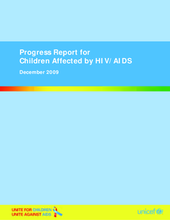The 2009 Progress Report for Children Affected by HIV/AIDS is the second in a periodic series sponsored by UNICEF designed to provide a summary of indicators of the current status of orphans and vulnerable children (OVC). The objective of this report is to provide an easy-to-use guide to facilitate dialogue among both policymakers and key stakeholders about policies related to orphans and vulnerable children. It presents the 17 indicators described in the Guide to Monitoring and Evaluation of the National Response for Children Orphaned and Made Vulnerable by HIV/AIDS (UNICEF, 2005). Ten of these are considered core indicators, recommended as essential to monitoring and evaluating national programmatic efforts regarding orphans and vulnerable children; seven additional indicators supplement the core. All correspond to the five key strategies1 for mounting an effective response to the critical situation of children affected by HIV/AIDS:
- Strengthening the capacity of families to protect and care for children.
- Mobilizing and strengthening community-based responses.
- Ensuring access to essential services
- Ensuring that governments protect the most vulnerable children.
- Raising awareness to create a supportive environment.
The results of the 2006 Progress Report for Children Affected by HIV/AIDS highlighted the limited nature of the data available to measure the status of OVC. This led to improvements in the design of various surveys, including the Demographic and Health Surveys (DHS), the AIDS Indicator Surveys (AIS) and the Multiple Indicator Cluster Surveys (MICS). In addition, it also spurred efforts to strive for consistent methodologies across surveys, so that data gathered in different surveys could be effectively compared and combined when presenting these summary results. This report reflects the fruits of those efforts, which constitute an improved base of information upon which to make strategic responsive decisions in support of children affected by HIV/AIDS.

